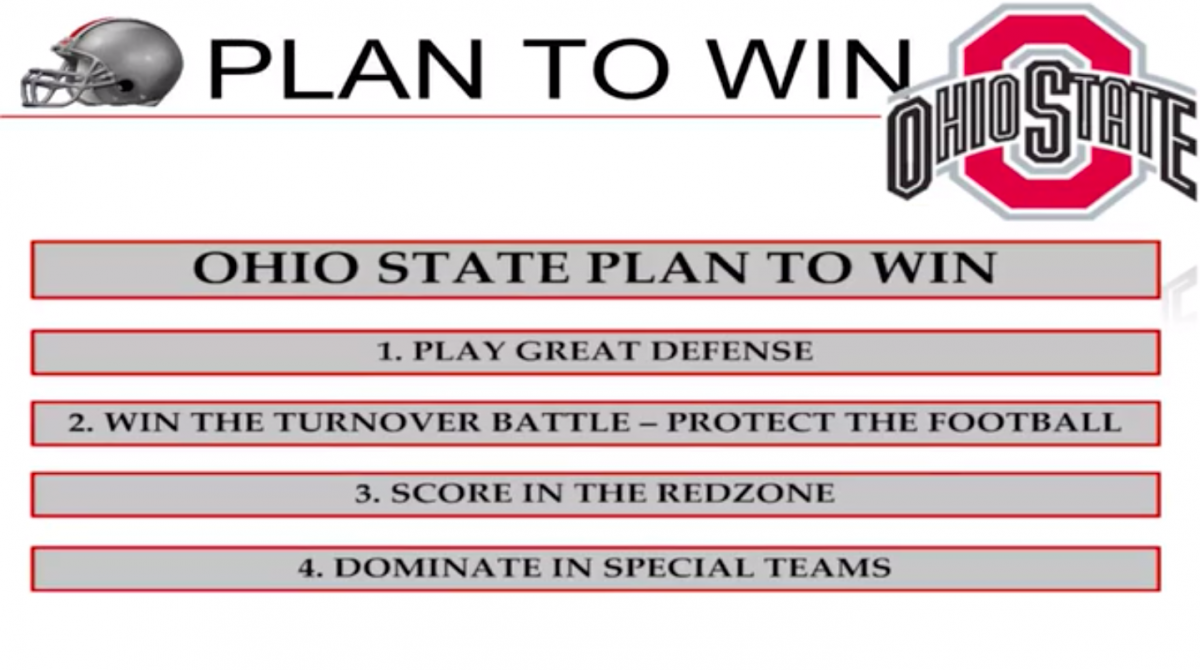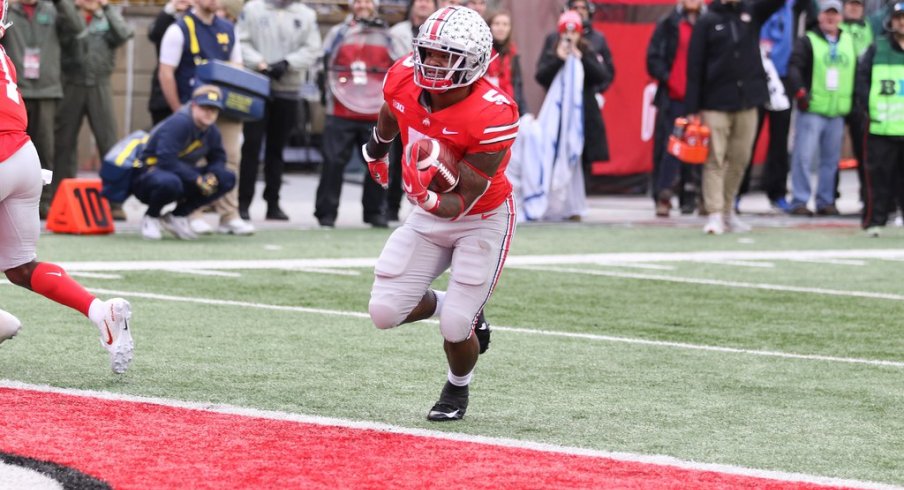Despite re-writing countless records last fall, it's not as if Dwayne Haskins and the 2018 Ohio State offense was without its flaws. Though the Buckeyes led the nation in passing yards and trailed only the Oklahoma Sooners in total yards-per-game, there were still areas in which the team struggled.
Though Urban Meyer had always stressed the importance of scoring touchdowns once inside the red zone since taking over the program in 2012, the Buckeyes often fell short in their efforts to do so during what would be his final season in charge. Meyer was so committed to the cause that he put it on the first page of the playbook given to his team each and every season, outlining it in his 'Plan to Win.'

Yet while the Buckeyes had one of the nation's most explosive offenses in 2018, they were one of the worst once inside the 20. Last season, Ohio State entered the red zone on 70 occasions but only scored a touchdown 43 times.
| Year | Red Zone Score % | National Rank |
|---|---|---|
| 2012 | 88.2% | 16th |
| 2013 | 95.2% | 4th |
| 2014 | 85.1% | 49th |
| 2015 | 82.5% | 81st |
| 2016 | 87.1% | 40th |
| 2017 | 89.7% | 23rd |
| 2018 | 77.1% | 116th |
After years of relying on the running abilities of Braxton Miller and J.T. Barrett, who combined to rack up 68 rushing touchdowns from the quarterback position under Meyer's watch, the switch to a pocket passer like Haskins meant the team would have to adapt. Through the first 10 games, however, that transformation had yet to take place.
Capped by a miserable, two-week stretch against Minnesota and Purdue in October during which the Buckeyes failed to score a touchdown after entering the red zone on eight straight attempts, it was clear that the OSU offense was in trouble. While the Buckeyes saw failures on both sides of the ball in their 49-20 loss at West Lafayette, it certainly didn't help that they entered the red zone five times that night and came away with only a pair of field goals while the Boilermakers found the end zone on all three of their trips.
After that loss, panic began to set in. Though Haskins was racking up passing yards like no other signal caller in scarlet and gray had done before, many in central Ohio were clamoring for a two-quarterback system. The reason for such a shift was clear: without a running threat at QB, the Buckeye running game was too predictable, allowing teams to focus on stuffing the efforts of J.K. Dobbins and Mike Weber.
"Running Dwayne down there really isn't as much of an option as it used to be with J.T.," Ryan Day said to the press that following week. But while backup Tate Martell did get a handful of chances to play near the goal line come November, his presence wasn't what revived the OSU red zone offense.
After weeks of hand-wringing, the Buckeyes quietly turned things around at just the right time. During the final four games, they scored touchdowns on 17 of 24 red zone attempts, finding ways to pound the ball in once near the goal line.
First and foremost, an added diversity in scheme helped revive the running game. Though Ohio State has long run the common Power scheme in which the backside guard pulls around to lead a runner through the front-side B-gap, they added a C-gap variation often only seen in Wing-T systems.
While everyone from the center to the tight blocks down on the front side, the pulling guard kicks out the defensive end, creating a crease between he and the tight end and allowing the back to hit the edge. As seen below in the Rose Bowl, however, this lateral flow also created cutback lanes that allowed a back with the vision and agility of Dobbins to bend the play back and waltz into the end zone.
Though Haskins wasn't much of a runner, Day and the staff still found ways to incorporate him into the option game and create a numbers advantage near the goal line. Instead of taking a passive role and only keeping to run himself if the defense committed to stopping Dobbins or Weber, the Buckeyes became the aggressors and forced defenders to commit to Haskins via the speed option.
As seen above, the Buckeyes ran these concepts from their base, 11 personnel featuring just one back, one tight end, and three receivers. By sending the H (slot) receiver in motion, Haskins could get an easy read to determine the defense's intentions.
After seeing their rivals utilize man-coverage in the goal-line situation shown above, the Buckeyes followed up that speed option by copying the same personnel and motion with K.J. Hill in their next trip to the red zone. The second time around, however, Hill sliced back across the formation underneath the shallow crossing route of the Z receiver outside, creating a pick on his defender and allowing Haskins to easily toss a touchdown pass.
Those seemingly insignificant motions were quite helpful for Haskins, who by season's end had mastered the art of reading defenses. Even when the Buckeyes eventually bulked up and utilized 13 personnel (1 back, 3 tight ends) near the goal line, Day gave the young QB clues that allowed him to make quick and easy reads in the passing game.
Though the Buckeyes began lining up with two and three tight ends far more often during this successful late-season stretch, the team's best personnel package clearly remained a four-receiver set featuring Hill, Terry McLaurin, Johnnie Dixon, and Parris Campbell on the field at the same time. While such a look made it more difficult to run the ball in short-yardage, defenses were stretched to defend so much speed from sideline to sideline.
Hill, in particular, proved extremely effective in these situations, using his superior quickness to separate from interior defenders and give his quarterback an open window.
Finding ways to isolate the Buckeyes' superior athletes on slower defenders ultimately proved to be the key to finding success once the field shrunk. Though Northwestern hardly relied on straight man-coverage in the Big Ten championship game, Day knew their zone-match coverage would ultimately leave an inside linebacker chasing Dobbins out of the backfield should he release.
Though the program is now firmly in the hands of Day, the first-time head coach has made it clear that his plan to win is no different than his predecessor's. Scoring touchdowns near the goal-line remains a top priority which will be emphasized from day one of training camp.
That order will be made easier as once again the Buckeyes will have a dual-threat runner lining up under center this fall in Justin Fields. But just because they have the personnel to run the zone-read in goal-line situations, it doesn't mean they should. After showing a diversified attack and returning Hill along with all three tight ends in 2019, maintaining a balanced attack when arriving inside the 20 could not only make Ohio State efficient near the goal-line, but perhaps even unstoppable.



